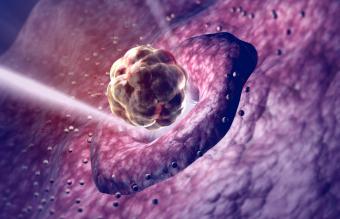
According to HopkinsMedicine.org, the first trimester of pregnancy is critical to healthy fetus development, as all the major systems and organs grow. It is also a time when hormonal changes can contribute to vaginal yeast infections in the mother. As the developing baby is especially vulnerable to medications, treatments, and environmental toxins at this time, it is crucial that first trimester treatments of yeast infections be safe and recommended by your health care provider.
Safest Early Pregnancy Yeast Infection Treatments
While oral anti-fungal therapy should not be used by pregnant patients, as indicated by MedicineNet.com, anti-fungal topical preparations are safe and effective treatments for managing yeast infections during the first trimester of pregnancy and beyond. The British Association for Sexual Health and HIV indicates that yeast infections in pregnant women should be treated with topical azoles.
Is it ok to use Monistat while pregnant? According to Roger Harms, MD of the Mayo Clinic, both miconazole and clotrimazole are safe to use at any point during pregnancy. These medications are available over-the-counter and in prescription strength. It is further noted that using these preparations pose no risk of pregnancy complications or birth defects. Prior to using these preparations, however, speak to your health care provided to determine if they are appropriate for your situation.
Miconazole (Monistat)
According to MedlinePlus, an informational website sponsored by the National Institutes of Health, miconazole is an anti-fungal agent used in the treatment of athlete's foot and vaginal yeast infections. According to Patient.Co.Uk, miconazole works by killing the Candida yeast fungus, which is what causes yeast infections.
- Side effects: Miconazole can cause side effects such as irritation or burning of vaginal skin, fever, stomach pain, and foul-smelling vaginal discharge, according to Medline Plus.
- Options: When used in the treatment of vaginal yeast infections, miconazole cream is delivered via an applicator, and it is also available as a vaginal suppository.
- Application: According to DailyMed.com, an informational website managed by the National Institutes of Health, one applicator of miconazole cream should be inserted into the vagina for seven consecutive nights in a row to treat vaginal yeast infections. Always wash the applicator between uses.
- Symptom relief: If your symptoms do not improve after three days, or if they last more than seven days, stop using miconazole and notify your physician.
Clotrimazole (Gyne-Lotrimin)
Clotrimazole is also an anti-fungal agent that is commonly used to treat vaginal yeast infections. According to NetDoctor.Co.Uk, clotrimazole works by killing yeasts and fungi by the interference of their cell membranes, stopping the production of ergosterol. When the production of ergosterol is halted or disrupted, the cell membrane becomes compromised by holes. These holes cause essential properties of the fungal cells to leak out, which ultimately kills the fungus, while treating the infection.
- Side effects: According to Medscape, clotrimazole topical cream can produce side effects such as itching, burning, redness, blistering, peeling skin, edema or swelling, and general skin irritation.
- Caution: DailyMed.com, warns that clotrimazole should not be used if you have never had a vaginal yeast infection diagnosed by your physician.
- Application: One applicator full of clotrimazole cream should be inserted vaginally for seven days in a row, every night. You should also thoroughly clean the application before every use.
- Symptom relief: As with miconazole, symptoms should improve after three days, and if your symptoms last for more than one week, notify your doctor.
Preventive Considerations
While yeast infections are common in the first trimester, there are a number of safe home remedies you can use to stave them off. In addition to keeping your genital area dry and avoiding feminine hygiene sprays, there are additional steps you can take to reduce your risk of developing a yeast infection, thereby eliminating the need for treatment. These include:
- Wearing breathable, cotton underwear
- Avoiding bubble baths or perfumed soaps
- Avoiding douching during pregnancy (note that it is not safe to douche during pregnancy for any reason)
- Eating yogurt, which can restore the "good" bacteria in the vagina
Seek Medical Care
While prevention helps reduce the risk, fluctuating hormones during early pregnancy make the vaginal area a breeding ground for the development of yeast overgrowth. Even if you follow all prevention considerations, you still may experience an infection.
According to WomensHealth.gov, yeast infections do not threaten the health of the baby, but they may be uncomfortable and difficult to treat during pregnancy. Seeing your doctor at the first sign of a yeast infection can help reduce the risk of severe symptoms, as well as allow you to verify that your symptoms are, in fact, related to a yeast infection rather than another medical condition. Be sure to speak with your health care provider before deciding to self-treat.







